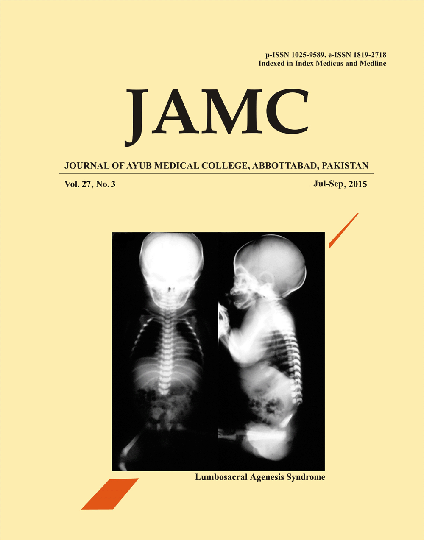FREQUENCY OF HOSPITAL ACQUIRED HYPONATREMIA IN A PEDIATRIC TERTIARY CARE SETTING
Abstract
Background: Hyponatremia is the most commonly encountered electrolyte disorder in children. In our country the epidemiology of hospital acquired hyponatremia has hardly ever been explored whereas the administration of hypotonic IV fluids is widely practiced here. Therefore we pioneered to conduct this study to determine the frequency of hospital acquired hyponatremia. Methods: This was a cross sectional study carried out at Aga Khan University Hospital, Karachi in paediatric ward and ICU over a period of 12 months. All children (>1 month and <15 years of age ) admitted in paediatric units and on maintenance IV fluids who had serum sodium level measured on admission ,were included in the study and followed to identify patients who had a drop in serum sodium during hospitalization. Informed consent was taken from parents and collected data was recorded on a pro forma. Results: A total of 865 patients were enrolled in the study. Hyponatremia was recorded in 405 patients on admission (46.8%) while hospital acquired hyponatremia was documented in 240 children (27.7%). Out of these 142 (59.2%) were male and 98 (40.8%) were female. Mean age of children in hospital acquired hyponatremia group was 60.67 months. Severity of hospital acquired hyponatremia was recorded as mild in 191 (79.6%), moderate in 35 (14.6%) and severe in 14 (5.8%) children. Major disease categories included gastrointestinal disorder (30.4 %), respiratory illness (12.5%), oncological disease (16.3%), cardiovascular disease (11.7%), infectious disease (9.2%) and neurological illness (8.3%). Conclusion: Hospital acquired hyponatremia is frequently encountered in our hospitalized children with majority of them receiving hypotonic IV solutions.
References
Asadollahi K, Beeching N, Gill G. Hyponatraemia as a risk factor for hospital mortality. QJM 2006;99(12):877-80.
Moritz ML, Ayus JC. Preventing neurological complications from dysnatremias in children. Pediatr Nephrol 2005;20(12):1687-700.
Arieff AI, Ayus JC, Fraser CL. Hyponatraemia and death or permanent brain damage in healthy children. BMJ 1992;304(6836):1218-22.
Moritz ML, Ayus JC. Hospital-acquired hyponatremia--why are hypotonic parenteral fluids still being used? Nat Clin Pract Nephrol 2007;3(7):374-82.
Beukhof CM, Hoorn EJ, Lindemans J, Zietse R. Novel risk factors for hospital-acquired hyponatraemia: a matched case-control study. Clin Endocrinol (Oxf) 2007;66(3):367-72.
Holliday MA, Segar WE. The maintenance need for water in parenteral fluid therapy. Pediatrics 1957;19(5):823-32.
Keating JP, Schears GJ, Dodge PR. Oral water intoxication in infants. An American epidemic. Am J Dis Child 1991;145(9):985-90.
Hoorn EJ, Geary D, Robb M, Halperin ML, Bohn D. Acute hyponatremia related to intravenous fluid administration in hospitalized children: an observational study. Pediatrics 2004;113(5):1279-84.
Hanna S, Tibby SM, Durward A, Murdoch IA. Incidence of hyponatraemia and hyponatraemic seizures in severe respiratory syncytial virus bronchiolitis. Acta Paediatr 2003;92(4):430-4.
Stelfox HT, Ahmed SB, Khandwala F, Zygun D, Shahpori R, Laupland K. The epidemiology of intensive care unit-acquired hyponatraemia and hypernatraemia in medical-surgical intensive care units. Crit Care 2008;12(6):R162.
Wattad A, Chiang ML, Hill LL. Hyponatremia in hospitalized children. Clin Pediatr (Phila) 1992;31(3):153-7.
Sarnaik AP, Meert K, Hackbarth R, Fleischmann L. Management of hyponatremic seizures in children with hypertonic saline: a safe and effective strategy. Crit Care Med 1991;19(6):758-62.
Halberthal M, Halperin ML, Bohn D. Lesson of the week: Acute hyponatraemia in children admitted to hospital: retrospective analysis of factors contributing to its development and resolution. BMJ 2001;322(7289):780-2.
Yawar A, Jabbar A, Haque NU, Zuberi LM, Islam N, Akhtar J. Hyponatraemia: etiology, management and outcome. J Coll Physicians Surg Pak 2008;18(8):467-71.
Hasegawa H, Okubo S, Ikezumi Y, Uchiyama K, Hirokawa T, Hirano H, et al. Hyponatremia due to an excess of arginine vasopressin is common in children with febrile disease. Pediatr Nephrol 2009;24(3):507-11.
Don M, Valerio G, Korppi M, Canciani M. Hyponatremia in pediatric community-acquired pneumonia. Pediatr Nephrol 2008;23(12):2247-53.
Armon K, Riordan A, Playfor S, Millman G, Khader A. Hyponatraemia and hypokalaemia during intravenous fluid administration. Arch Dis Child 2008;93(4):285-7.
Downloads
Published
How to Cite
Issue
Section
License
Journal of Ayub Medical College, Abbottabad is an OPEN ACCESS JOURNAL which means that all content is FREELY available without charge to all users whether registered with the journal or not. The work published by J Ayub Med Coll Abbottabad is licensed and distributed under the creative commons License CC BY ND Attribution-NoDerivs. Material printed in this journal is OPEN to access, and are FREE for use in academic and research work with proper citation. J Ayub Med Coll Abbottabad accepts only original material for publication with the understanding that except for abstracts, no part of the data has been published or will be submitted for publication elsewhere before appearing in J Ayub Med Coll Abbottabad. The Editorial Board of J Ayub Med Coll Abbottabad makes every effort to ensure the accuracy and authenticity of material printed in J Ayub Med Coll Abbottabad. However, conclusions and statements expressed are views of the authors and do not reflect the opinion/policy of J Ayub Med Coll Abbottabad or the Editorial Board.
USERS are allowed to read, download, copy, distribute, print, search, or link to the full texts of the articles, or use them for any other lawful purpose, without asking prior permission from the publisher or the author. This is in accordance with the BOAI definition of open access.
AUTHORS retain the rights of free downloading/unlimited e-print of full text and sharing/disseminating the article without any restriction, by any means including twitter, scholarly collaboration networks such as ResearchGate, Academia.eu, and social media sites such as Twitter, LinkedIn, Google Scholar and any other professional or academic networking site.










